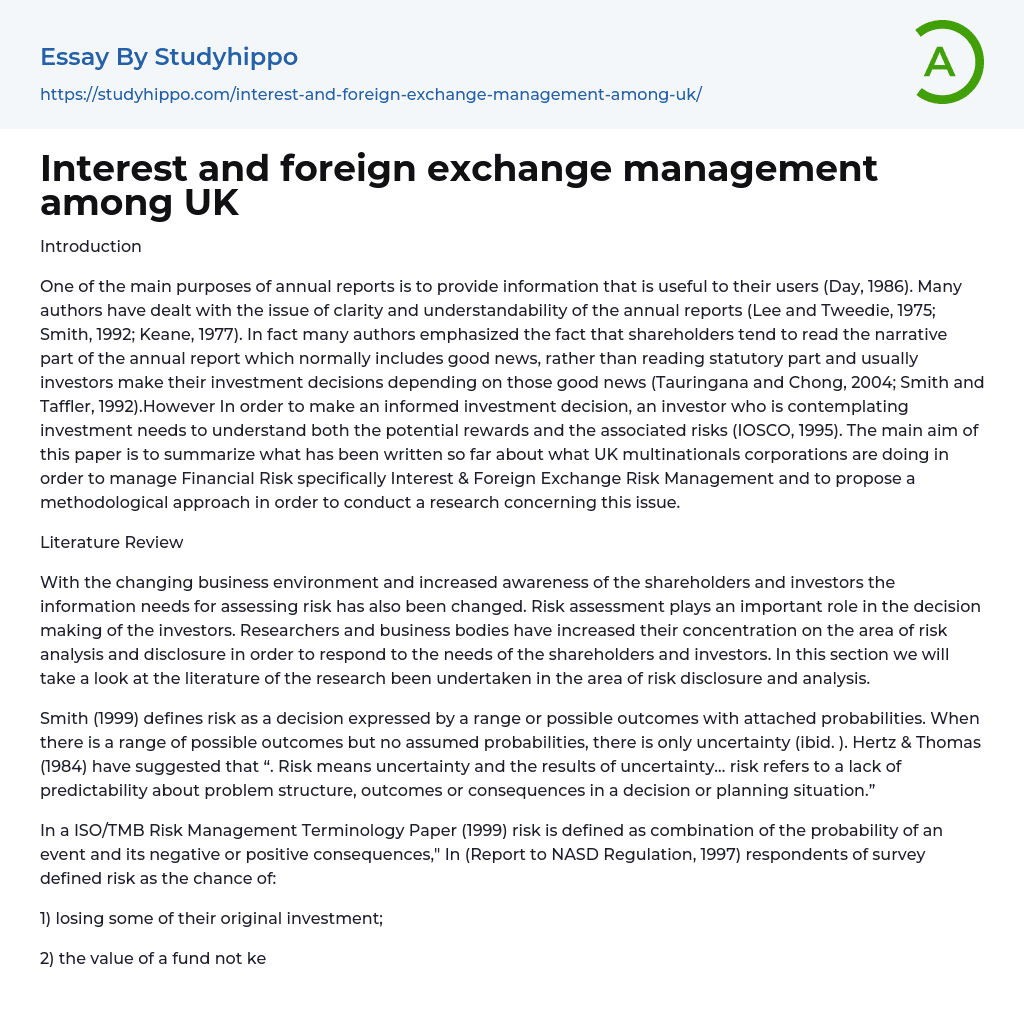

Interest and foreign exchange management among UK Essay Example
Introduction
Annual reports have the primary purpose of providing valuable information to their users (Day, 1986). The topic of clarity and comprehensibility in annual reports has been addressed by various authors (Lee and Tweedie, 1975; Smith, 1992; Keane, 1977).
Shareholders focus on the narrative part of annual reports, which contains positive news, influencing their investment decisions as they rely on this information (Tauringana and Chong, 2004; Smith and Taffler, 1992). However, investors need to understand both potential rewards and associated risks in order to make informed investment decisions (IOSCO, 1995).
This paper aims to summarize existing literature on how UK multinationals manage financial risks such as interest rate and foreign exchange risk. It also proposes a methodological approach for researching these issues.
Literature Review
The business environment is constantly changing and shareholders and investors are more awar
...e. Therefore, the necessary information for assessing risk has also evolved. Risk assessment plays a crucial role in investor decision-making. Researchers and business organizations have focused more on analyzing and disclosing risks in response to the needs of shareholders and investors.
This section will explore the literature related to research on risk disclosure and analysis. Smith (1999) defines risk as a decision that involves multiple potential outcomes, each with its own probability. If there is a range of outcomes without assigned probabilities, uncertainty exists (Smith, 1999). Furthermore, Hertz & Thomas (1984) suggest that ".
Risk is the lack of predictability in decision-making or planning, involving uncertainty about the structure, outcomes, or consequences of a problem. According to the ISO/TMB Risk Management Terminology Paper (1999), it combines the probability of an event and its positive or negative consequences. In a survey conducted for the Report t
NASD Regulation (1997), respondents defined risk as the probability of various outcomes, such as losing part of their investment, funds not keeping pace with inflation, fluctuations in fund value, failure to achieve financial goals, decreased distributed income, underperformance compared to bank certificates of deposit or an index, and incurring losses within the first year of an investment. Risk is inherent in business and plays a crucial role in earning returns for owners. To accurately assess a company's future performance potential, investors must have a proper understanding of the risks it takes on. This understanding is based on analyzing the risks impacting the company's business and quantifying these risks using appropriate methods (ICAEW, 2002).
Managing the risks faced by a company is a complex task, as it involves describing the risk associated with specific investment products. This can be challenging due to varying investment objectives, risk preferences, and abilities of investors to understand risk. Therefore, establishing general guidelines for disclosure becomes difficult. The company faces three types of exchange rate risk exposure: translation exposure, transaction exposure, and economic exposure.
Translation exposure refers to changes in accounting income and balance sheet statements caused by fluctuations in exchange rates. It occurs when a credit sale is translated at one exchange rate while the obligation was originally recorded at another.
On the other hand, economic exposure relates to changes in expected future cash flows and economic value resulting from changes in exchange rates (Van Horne & Wachowicz, 2001).
Reasons For Choosing This Topic
The decision to focus on this topic was driven by the scarcity of literature addressing firms' management of interest rate and foreign exchange risk. The lack of research in
this area has inspired me to contribute new insights to the current body of knowledge. Furthermore, numerous investors possess limited knowledge in accounting, making it difficult for them to comprehend annual reports effectively. It is essential for investors to grasp the correlation between risk and return when evaluating a company's performance. Consequently, this study aims to emphasize the importance of managing interest rate and foreign exchange risk for companies.
The study aims to evaluate how effectively UK companies manage the risks associated with interest rates and foreign exchange.
- Investing essays
- Asset essays
- Depreciation essays
- Discounted Cash Flow essays
- Foreign Direct Investment essays
- Funds essays
- Internal Rate Of Return essays
- Revenue essays
- Day Trading essays
- Futures Trading essays
- Capital market essays
- Million essays
- Payment essays
- Rate Of Return essays
- Funding essays
- Hedge Fund essays
- Board Of Directors essays
- Brand Management essays
- Business Ethics essays
- Business Management essays
- Change Management essays
- Comparative Analysis essays
- Decision Making essays
- Dispute Resolution essays
- Knowledge Management essays
- Leadership essays
- Leadership and Management essays
- Manager essays
- Operations Management essays
- Performance Management essays
- Product Management essays
- Project Management essays
- Quality Management essays
- Risk essays
- Risk Management essays
- Scientific Management essays
- Stress Management essays
- supply chain management essays
- Time Management essays
- Total Quality Management essays
- Absolutism essays
- Appeal essays
- Bourgeoisie essays
- Contras essays
- Corporate Governance essays
- Corruption essays
- Democracy essays
- Democratic Party essays
- Developed Country essays
- Dictatorship essays



